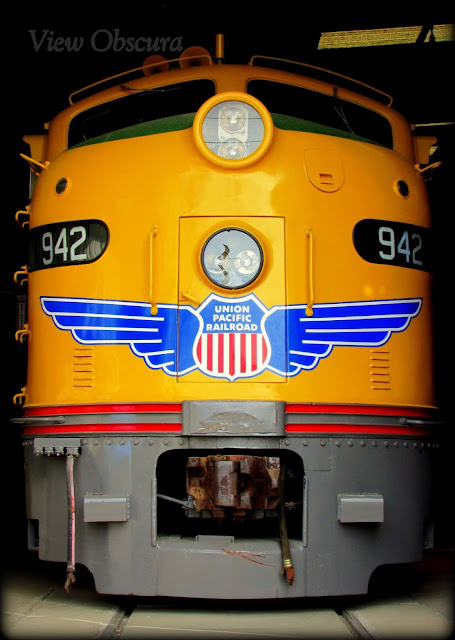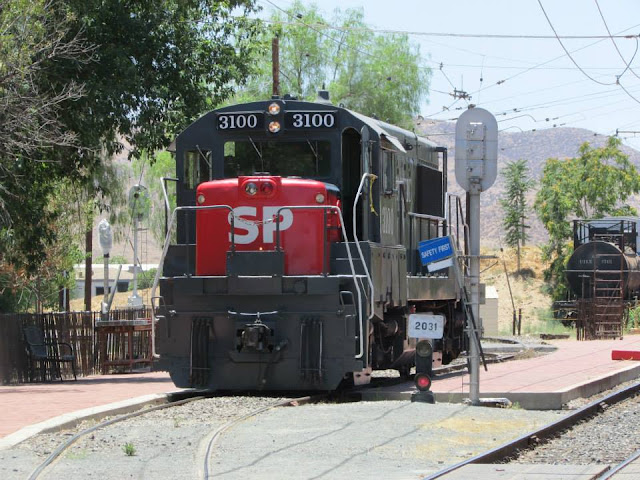Story & Photos By: Ken Hulsey
Modern Times & Twilight of the Railroad Era
Here are some fun and interesting facts from the post-war era of American railroading circa 1945-1980. It was a time of transition as railroads moved from traditional steam power to diesel and railroads tried to compete with other growing forms of transportation.
After WWII the economical and social environment of the United States changed drastically. The railroads main forms of competition, which had been held back due to the war, were now free to serve the public. Factories that once built weapons now were churning out automobiles, gasoline that was rationed during the war was now cheap and plentiful, buses had cheaper fares, interstate highways were constructed and airlines grew in number. All these factors, combined with anti-railroad legislation left over from the turn of the century, spelled hard times for the railroads. Passenger and freight traffic experienced a sharp rate of decline after the war.
Cars, trucks and buses utilized an interstate highway system that was built with government money. Likewise airlines were heavily subsidized. While the government was investing money in other forms of transportation the railroads had to maintain their own rails (Highways were maintained by the government) and pay heavy taxes.
When the railroads switched from steam to diesel during the decade after WWII the work force changed drastically. There was no longer a need for the massive maintenance shops the kept the fleet of steamers up and running. This was an extreme hardship in several small towns where the locomotive shops were the areas main employer.
President Kennedy devised “Arbitration Award 282” in August 1963. This allowed they railroads to do away with the now unnecessary position of “fireman” on passenger and freight trains. The main provision of this act was that railroads simply couldn't fire all of their fireman. Existing fireman would be allowed to retire, resign or accept a severance package.
General Motor’s Electro-Motive Division – Became an industry leader.
Fairbanks-Morse – Built early gasoline driven rail cars, 1,000 hp switchers and a limited amount of road diesels. Went out of business in 1958.
Baldwin – The steam locomotive giant bought the Lima Locomotive Company in 1950. Used Westinghouse equipment to build diesel-electric locomotives. Though the manufacturer had lucrative contracts and built 3,000 units, its practice of marketing “customized diesels” proved antiquated.
The American Locomotive Company (ALCO) – Allied with GE to gain an early hold in the locomotive market. Produced a 2,000hp locomotive for dual freight and passenger service. GE severed its relationship and the company went out of business, although it still built locomotives through the Montreal Locomotive Works until 1969.
The EMD GP7 & GP9 were very unique locomotives. The design was initially envisioned as a switcher, but its good visibility in both directions leads to its use a mainline workhorse. Overall 6,000 “Geeps” were produced and many units remained in service until the 1990s’.
In the 1950s’ and 60s’ the American and Canadian railroads made several attempts to lure passengers. The US railroads sponsored a radio program to keep the industry in the public eye. Railroads from both countries introduced “Vista Dome” cars that gave passengers an exceptional view of the countryside. New private sleeping cars were introduced. The Canadian railroads even tried a moderately successful staggered rate program known as the “Red. White & Blue Fares.” Railroads even developed new modern looking logos and shiny new cars, but in the end it made little difference.
Although the Pennsylvania and New York Central merged into one railroad, the Penn Central, the railroad still operated as if they were still separate. Crews from the individual railroads often fought and had trouble learning the practices of the other railroad. Shipments being delivered to the wrong destination and derailments were common. When the ICC ordered that the failing New York, New Haven & Hartford to merge into the Penn Central things became even more complicated. The line began bankruptcy proceedings in 1970.
Union Pacific vice-president William McDonald came up the idea of forming Conrail to bail out the failing Penn Central, Lehigh Valley, Central of New Jersey and Reading railroads.
Railroads began to use telephones, television monitors, microwave communications, computers, classification yards, hot box detectors, undercarriage inspection units, Timken roller bearings and disc brakes.
TOFC – Trailer on Flat Car is the shipment of truck trailers on a railroad flat car.
COFC – Container on Flat Car is the shipment of a international shipping container on a railroad flat car.
Auto Railers – Is the practice of attaching railroad wheel trucks directly to trailers or containers to eliminate the use of a flat car.
Unit Trains – Unit trains are comprised of one type of freight car that hauls one specific commodity such as coal or wheat.
Mini Trains- Mini Trains are 10 to 15 car Unit Trains.
Due to the changing economic climate and the decline of rail service the Pullman Company, REA and US Railway Mail Service became outdated and unneeded.
Check Out:





















No comments:
Post a Comment